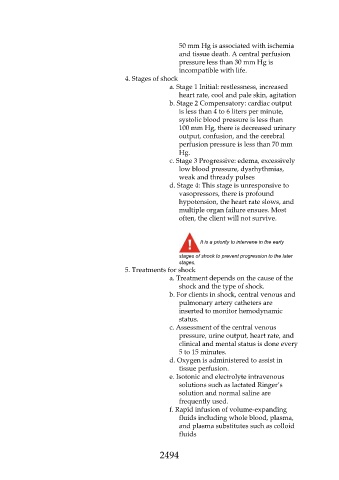Page 2494 - Saunders Comprehensive Review For NCLEX-RN
P. 2494
50 mm Hg is associated with ischemia
and tissue death. A central perfusion
pressure less than 30 mm Hg is
incompatible with life.
4. Stages of shock
a. Stage 1 Initial: restlessness, increased
heart rate, cool and pale skin, agitation
b. Stage 2 Compensatory: cardiac output
is less than 4 to 6 liters per minute,
systolic blood pressure is less than
100 mm Hg, there is decreased urinary
output, confusion, and the cerebral
perfusion pressure is less than 70 mm
Hg.
c. Stage 3 Progressive: edema, excessively
low blood pressure, dysrhythmias,
weak and thready pulses
d. Stage 4: This stage is unresponsive to
vasopressors, there is profound
hypotension, the heart rate slows, and
multiple organ failure ensues. Most
often, the client will not survive.
It is a priority to intervene in the early
stages of shock to prevent progression to the later
stages.
5. Treatments for shock
a. Treatment depends on the cause of the
shock and the type of shock.
b. For clients in shock, central venous and
pulmonary artery catheters are
inserted to monitor hemodynamic
status.
c. Assessment of the central venous
pressure, urine output, heart rate, and
clinical and mental status is done every
5 to 15 minutes.
d. Oxygen is administered to assist in
tissue perfusion.
e. Isotonic and electrolyte intravenous
solutions such as lactated Ringer’s
solution and normal saline are
frequently used.
f. Rapid infusion of volume-expanding
fluids including whole blood, plasma,
and plasma substitutes such as colloid
fluids
2494

